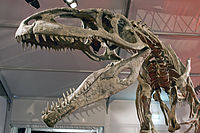Carnosauria
| Carnosaurs Temporal range: Middle Jurassic–Late Cretaceous, 175.6–70 Ma |
|
|---|---|
 |
|
| Replica Giganotosaurus carolinii skeleton | |
| Scientific classification | |
| Kingdom: | Animalia |
| Phylum: | Chordata |
| Class: | Reptilia |
| Clade: | Dinosauria |
| Order: | Saurischia |
| Suborder: | Theropoda |
| Clade: | Avetheropoda |
| Clade: |
†Carnosauria von Huene, 1920 |
| Subgroups | |
Carnosauria is a large group of predatory dinosaurs that lived during the Jurassic and Cretaceous periods. While it originally contained a wide assortment of giant theropods that were not closely related, the group has since been defined to encompass only the allosaurs and their closest kin. Starting from the 1990s, scientists have discovered some very large carnosaurs in the carcharodontosaurid family, such as Giganotosaurus and Tyrannotitan which are among the largest known predatory dinosaurs.
Distinctive characteristics of carnosaurs include large eyes, a long narrow skull and modifications of the legs and pelvis such as the thigh (femur) being longer than the shin (tibia).
Modern cladistic analysis defines Carnosauria as those tetanurans sharing a more recent common ancestor with Allosaurus than with modern birds.
Carnosauria has traditionally been used as a dumping ground for all large theropods, but analysis in the 1980s and 1990s revealed that other than size, the group shared very few characteristics, making it polyphyletic. Most former carnosaurs were reclassified as more primitive theropods (such as the megalosaurids, the spinosaurids, and the ceratosaurs). Others were placed in Coelurosauria if they were more closely related to birds, like the tyrannosaurids. Even non-dinosaurs were once considered carnosaurs, such as the rauisuchian Teratosaurus.
...
Wikipedia
